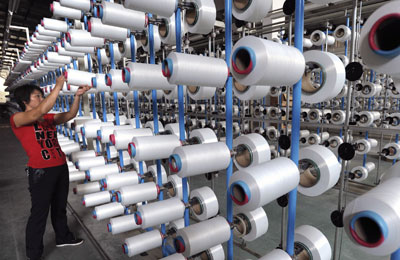
US manufacturing slows; Chinese factories rise
New York, April 2, 2013
Strong demand at home boosted activity at Chinese factories last month, but US manufacturing hit an unexpected speed bump after expanding rapidly in February, weakened by a slower pace of new orders.
Other surveys released on Monday showed manufacturing sectors in South Korea and Japan growing as exports increased, while Brazil faced sharply slower output and rapidly rising prices, suggesting a manufacturing recovery remained tenuous.
Most European markets were closed on Monday for Easter.
For the US and China, last month was largely a story of domestic demand. The US Institute for Supply Management's factory purchasing managers index showed new orders slowed sharply in March, a month after rising demand boosted the index to its highest level since mid-2011.
"This comes as a disappointment," said Tom Porcelli, chief US economist at RBC Capital Markets, who noted that recent strong consumer income and spending data last week had suggested the broader economy would grow strongly in the first quarter.
"What this support suggests is that the quarter probably ended with a loss of momentum," he said, adding RBC expects the economy to have grown by 3.2 percent at an annualised rate between January and March after expanding 0.4 percent in the fourth quarter of 2012.
"The biggest concern was the drop in new orders," said Craig Dismuke, chief economic strategist at Vining Sparks in Memphis, Tennessee. "Maybe we are seeing a cutback in business spending. We could see a slowdown in the spring."
However, a separate gauge of US manufacturing from financial information firm Markit showed the first quarter was the sector's best in two years and should contribute to overall first-quarter growth.
While the two surveys use the same sub-indexes, they give different weights to the components.
New orders at Chinese factories, meanwhile, rose sharply, though an uncertain outlook for exports could still slow the speed of economic recovery there. So, too, economists say, could premature tightening of China's current loose monetary policy.
The central bank eased conditions last year, thereby increasing credit and helping avert a more pronounced slowdown in the world's second largest economy.
"Growth momentum has been stabilising, but headwinds remain," Liu Li Gang and Zhou Hao, economists at ANZ, said in a note to clients. "The current economic rebound remains fragile, and could falter with tightened monetary policy conditions."
China's official manufacturing purchasing managers' index (PMI) released by the National Bureau of Statistics rose to an 11-month high of 50.9 in March. A separate survey by HSBC showed its final PMI climbing to 51.6 last month, in line with a flash reading of 51.7 and up from February's 50.4.
The rebound in China's PMIs in March comes after a choppy start to the year.
The official PMI in February fell to within a whisker of the 50-point mark that separates accelerating growth from contraction in China's giant factory sector. But investors mostly saw February's weak reading as a consequence of the Lunar New Year, as many Chinese factories closed for at least two weeks.
Most analysts expect China's economy to enjoy a steady but gentle recovery this year, driven internally by infrastructure investment and household consumption after growth struck 13-year lows in 2012 due to crumbling demand for Chinese exports.
ASIA, BRAZIL
Elsewhere in Asia, exports helped South Korean manufacturing grow at its fastest rate in a year, suggesting the beginning of a recovery.
A Markit/JMMA survey for Japan, released on Friday, showed manufacturing activity grew for the first time in 10 months, a sign that the Japanese economy was gaining momentum as a weaker yen was helping exporters.
The story in South Asia was gloomier, with slower domestic and overseas demand slowing India's manufacturing sector growth to its slowest pace since November 2011.
Brazil, another large developing economy, also saw manufacturing output slow sharply last month even as input prices rose at the fastest pace in 22 months and average selling prices jumped for a 13th consecutive month.
The decline to 51.8 in the HSBC Purchasing Managers' Index from 52.5 in February suggests the sector continues to lose steam after growing more than expected in the first month of 2013.
"The PMI survey suggests that economic activity in the manufacturing sector lost momentum after a very strong January," said Andre Loes, chief Brazil economist at HSBC. "On the other hand, the average reading for the first quarter of the year was ... the strongest since the first quarter of 2011. These results seem consistent with our view that the Brazilian economy is experiencing a moderate recovery in 2013."- Reuters







